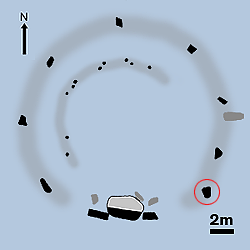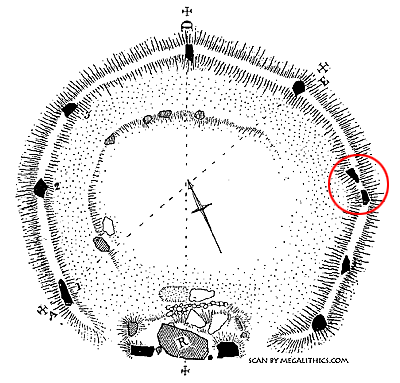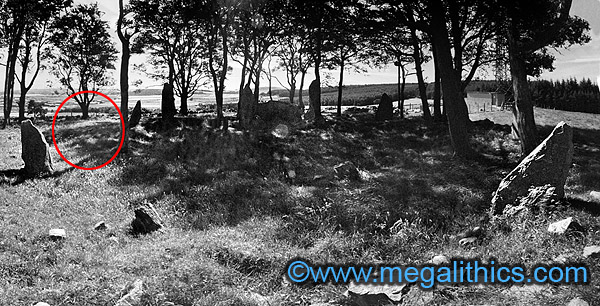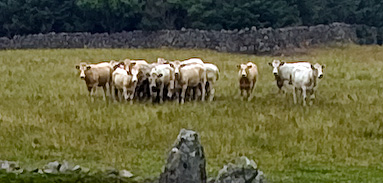

 |
 |
|
More Pics |
|
|
Panoramas |
||
|
|
InfraRed |
||
|
|
Antiquarian |
| NJ 85948 13209 133 (GPS 10min) | Diameter 18.1m (Pub.) |
| Visited August 1987, 2004 | Magnetic anomalies found |
Dyce is another recumbent circle that has survived to the present day in good condition, it has an alternative name of "Tyrebagger", or in older accounts "Tyr-bagger" or "Tyrie-bagger" which translates as "the land (or field) of acorns". The circle stands perched on the western slopes of Tyrebagger Hill about 3.5km from the centre of Dyce, overlooking Aberdeen airport. With an elevation of around 130m OD, the circle's location allows for sweeping panoramic views west over the countryside to the coast.
There seems to be some uncertainty in the literature regarding the number of stones originally present in this circle. Logan's plan (1) of 1829 shows ten circle stones (including the two flankers) standing, Fred Coles' plan of 1900 (2) (below left), shows an extra stone making a pair at the east (note that compass in Fred's plan is magnetic, true north is up) Thom's 1980 plan (3) shows one of this pair fallen, and on our visit in 1987 we found only nine stones standing with one fallen at the location previously occupied by the pair. The vacant stone location is circled in our 1987 photo below and it is interesting to compare this photo with Fred's excellent 1900 engraving of the site (below) which shows the two stones (also circled in red) in place and erect.
 |
 |

On our second visit in 2004 a stone had been erected at the location of the pair/fallen stone, this stone had a very irregular shape and was quite unlike any of the other circle stones. The most common explanation for the varying stone count is that the eastern stone was split, either by frost, or intentionally when the circle had been used as a cattle pen. Another disturbance to the circle stones is reported by Thom (4), after the great storms of 1953 he noticed that a tree had been uprooted at the circle and that its roots had extracted one of the circle stones, unfortunately he does not specify which stone was involved, but it has obviously been reinstated.
Whatever the original count, this is a circle of large impressive stones, the lowest is 1.3m high opposite the recumbent, and the two tallest are the flankers, lofty pillars 2.9m tall at the east and 3.4m at the west. The two flankers have very different shapes, the eastern having a "pointed tooth" shape similar to the rest of the original circle stones, whilst the western is a straight-sided pillar. The circle stone adjacent to the eastern flanker is almost its equal in height at 2.35m, and its shape is only similar to that of the western flanker, another straight-sided pillar, this led Keiller (5) to the opinion that the circle builders had mistakenly confused this stone with the eastern flanker. The stone is unusual in another respect, during our usual crude magnetic survey of the stones we found that this stone (red circled on our modern plan above) had magnetic properties. This stone was polarised with a vertical stripe of north pole on its inner face and a similar stripe of south pole on its outer, the effect was detectable over the entire exposed height of the stone.
The recumbent is also a substantial stone, 3.1m long it is presently leaning into the circle interior and is 1.6m tall with a central "hump", it is thought to weigh around 24 tons. The stones are graded in height up towards the recumbent standing at the S, both the grading and the location of the recumbent in the SW quadrant are characteristic features of an Aberdeenshire recumbent stone circle (RSC). The stones stand on a true circle of 18.1m, with the recumbent and flankers situated slightly within this circle a trait more commonly found in the RSC's of Kincardineshire. The circle stones are of local red granite, but the recumbent is of a dark grey granite, its inner face bearing the scorch marks made by the many fires that have been lit beneath it over the centuries.
There was almost certainly a ring-cairn at the site, in 1875 Maclagan (6) depicted an inner circle of flat stones set edge to edge 3.7m in from the circle stones, and also a concentric outer ring of stones 9m out from the circle. The remnant of the inner ring is still visible at the site today as a semi circle of stones peeping through the earth in the northern half of the circle interior. Traces of the outer ring are much harder to find as the circle is now closely bordered by the remains of a field wall over its north-western arc, but there may just be a suggestion of a wide low bank visible at the SE.
There appears to be a bank linking all of the stones and this gives the circle interior a "dished" appearance, during the circle's time as a cattle pen a dry stone wall was built on this bank, filling the gaps between the stones. Logan's 1829 plan shows the wall but suggests that the bank was pre-existing, this would fit with recent findings from Tomnaverie, Cothiemuir Wood and Aikey Brae RSC's where it was discovered that the ring-cairns predated the circles and that the circle stones were inserted through the cairn material (7,8).
The amount of vegetation within the circle has certainly reduced markedly over the last 100 years, Fred Coles describes the circle interior as "full of broom and whin" in 1900 (2). Although there were no bushes at the site during our visit in 1987, there were at least two substantial trees growing in the circle interior, both of these (and several other trees growing around the circle) had been removed when we visited again in 2004.
 |
| Just about to pay us a visit. |
During our 2004 visit to Dyce we were sharing the field with a herd of very inquisitive bullocks, so were unable to complete all of our usual coverage of the site, sorry.
1.
Logan J., Archaeologia, 22, p.410 pl,xxv, p.410, 1829.
2. Coles F.R.,
Proceedings of the Society of Antiquaries of Scotland, 34, p.188-95, 1899-1900.
3. Thom A., Thom A.S.,
Megalithic Rings, B.A.R. 81, p.195,1980,
Oxford.
4. Thom A., Thom A.S.,
Megalithic Remains in Britain and Brittany, p.3, Claredon Press, Oxford, 1978.
5.
Keiller A., Megalithic Monuments of North-East Scotland, p.9, 13, 15. London,
1934.
6. Maclagan C., The HIllforts, Stone Circles
and Other Structural Remains of Ancient Scotland, pl.xxvii, Edmonston &
Douglas, Edinburgh, 1875.
7. Bradley R., Discovery and Excavation in
Scotland, 1, p9 2000.
8. Bradley R., Antiquity, 74, p465-66,
2000.